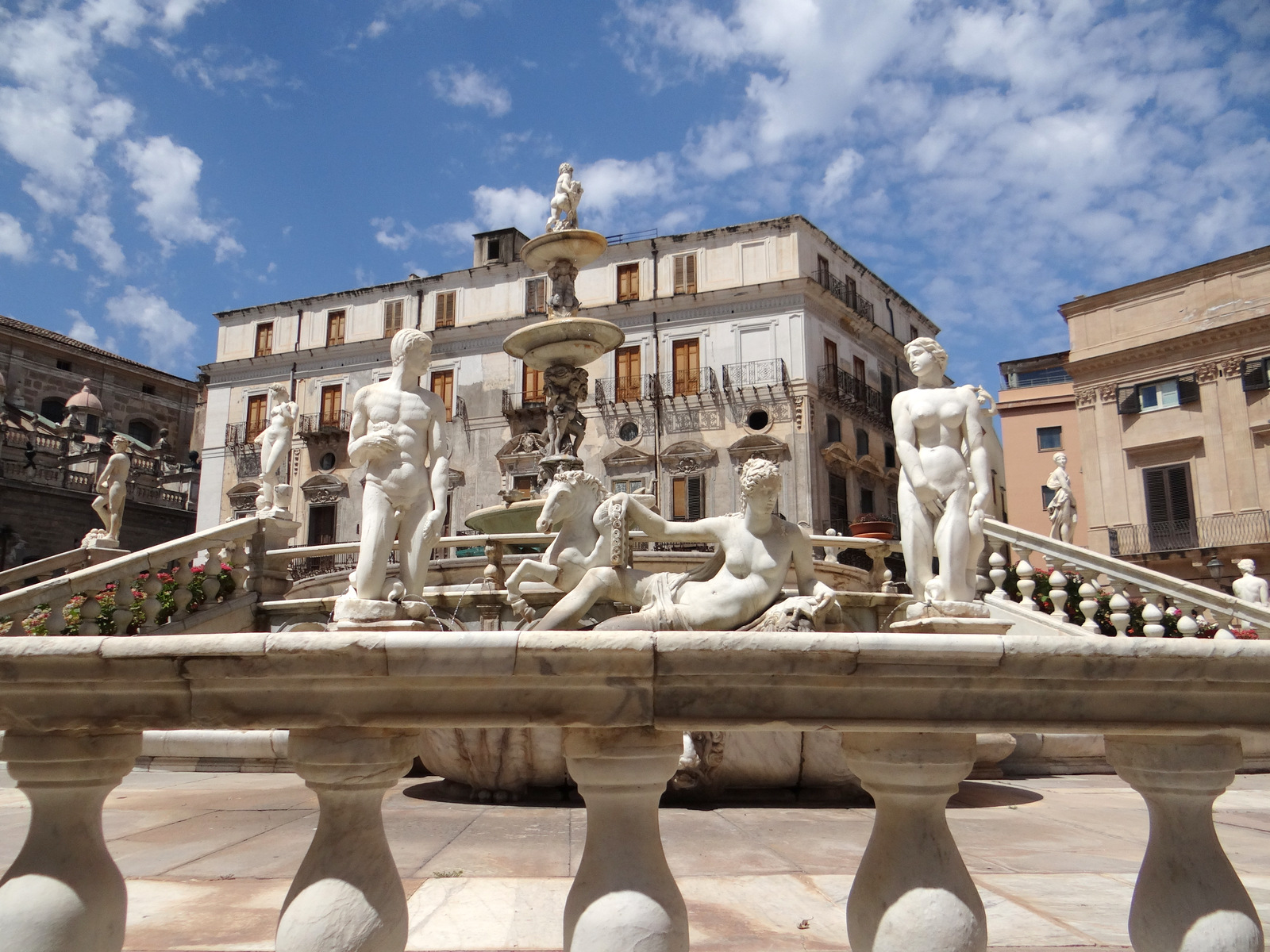
Read English version
Some twenty years later, it was sold to the Palermitan Senate to cope with The Toledo familys troubled debt situation and arrived in the old town in 1574.
Piazza of Shame, as Palermitans commonly call Piazza Pretoria, takes its name from the great amount of money that Palermo Senate had to pay for this purchase, though it is said that it is due to the nakedness of bodies.
It seems that the inhabitants of Palermo when the members of the Senate came out of the Palace shouted: “Shame, Shame” because of the sad historical moment of misery, epidemics and famine which characterized those years.
Three of the four sides are enclosed by buildings: the Praetorian Palace (the town hall) built in the fourteenth century and renovated in the nineteenth century, the Church of St. Catherine (end of sixteenth century), and two baronial palaces: Palazzo Bonocore and Palazzo Bordonaro. The fourth side of the square with a staircase descends to Via Maqueda.
The explanation of the significance of the statues “of shame” is due to the poet from Monreale Antonino Veneziano who reinterpreted the mythological and symbolic aspects of the Fountain in a local key.
The fountain is elliptical.
The first row is surrounded by elegant balustrades, interrupted by four large accesses, each marked by two statues on the edge which are colossal half-virile and feminine.
The Pretoria Fountain is full of hidden meanings like the mentioned bordering 8 statues that mark the boundaries. But these statues also represent the borders delimiting the space and time, a sort of door so as to have access to the heavenly Jerusalem.

The noses of the bordering statues, which are half animals and half men, seem added immediately afterwards as an ancient story tells that they were broken during the transportation in the coffers by the Messina inhabitants, who were envious of the Palermo recognition as the capital of the Kingdom. The inhabitants of Messina wanted to send an insulting message to Palermo, because the cutting of the nose was destined to pimps as their sentence.
The second row with four staircases displays four fish ponds, each with six niches adorned with animal heads. At the edge of each fish pond is placed a large tank, on its side lies a big statue representing a river and is lined with the statues of Tritons, Nereids and Sirenes.
Due to the moving of the fountain from Firenze to Palermo, the Florentine river Arno became the Palermitan river Oreto.
Hercules, placed right in front of the Palace, is represented with a club and symbolizes the power of the Nile. On the opposite side there is the River Papireto, while the source of Gabriele, which is the best one for its water in Palermo, is represented by a woman.
The fountain main groups are in Carrara marble while other elements are in Billiemi marble like the flight of the four stairs, whose name is uncertain (the stair of Hades or of the Roman gods stair or of love …)
Another mythological character is represented by Euterpe behind this one there is a winged statue which is undoubtedly Pegasus. In Greek mythology, Euterpe (greek Ευτέρπη, that who gives joy) is one of the Muses, who are the daughters of Zeus and Mnemosyne. It is the muse of music, later also of lyric poetry.
On the upper floor there is Opi (Cybele and Rhea) the primordial Roman goddess of the earth and you can see Mercury and Venus Verticordia whose influence ensured chastity in marriage. There is also Venus Callipigia, watching Adonis on the other side. And still Ceres or Demeter, the goddess of the harvest of fertility.
Ceres is watching his son Trittolemmo.
At the center of the fountain there is not the Genius of Palermo, as it is incorrectly testified by Antonio Veneziano, but a cherub with the geese that look towards the Cassaro ( because Palazzo Bordonaro had not yet been built).
The stele above the fountain is supported by four turtles, symbolizing the transition between heaven and earth. The base represented the Noah’s ark where, as you know, there were all the animal species while the second floor symbolized the heavenly Jerusalem.
Bernini was probably inspired by Camilliani, so in Piazza Navona he created the Fountain of the Four Rivers in 1654. About our Fountain, before arriving in Palermo, Giorgio Vasari wrote: “stupendous source that has no equal in Florence”.
